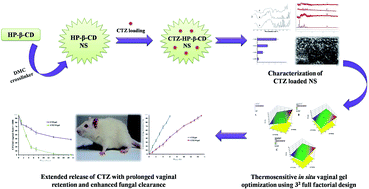A 32 full factorial design for development and characterization of a nanosponge-based intravaginal in situ gelling system for vulvovaginal candidiasis
Abstract
Clotrimazole (CTZ) is a Biopharmaceutics Classification System (BCS) Class II drug having a limited therapeutic potential because of its poor aqueous solubility and relatively short half-life. The rationale behind the present research effort was to enhance the solubility and efficacy of CTZ by having it form a complex with hydroxypropyl β-cyclodextrin (HP-β-CD) nanosponges. Nanosponges (NSs) are hyper-cross linked cyclodextrin polymer-based colloidal structures with three-dimensional networks. Herein, NSs were prepared using dimethyl carbonate as a cross linker, suitably gelled, and were assessed for in vitro release, in vitro bioadhesion, in vivo antifungal activity and in vivo irritation using female Wistar albino rats. Nine formulations were prepared based on a 32 full factorial design using different Pluronic F-127: Pluronic F-68 ratios. The prepared CTZ-HP-β-CD NS samples were characterized by carrying out SEM, TEM, and FT-IR spectroscopy studies, as well as DSC and XRPD studies. The average particle size of loaded NS (N6) was found to be 455.6 nm. This sample displayed the lowest polydispersity index of the samples tested, and displayed a high zeta potential (−21.32 ± 1.3 mV), indicative of a stable colloidal nanosuspension. The optimized CTZ NS-based in situ gel (F-10) demonstrated prolonged drug release (up to 15 h), considerably longer than that of the conventional in situ gel, whose drug release only lasted for less than 6 h. The CTZ-NS gel showed higher in vivo antifungal activity and in vitro bioadhesion than did the conventional in situ gel. Furthermore, in vivo irritation studies showed the optimized CTZ NS gel formulation to be a non-irritant. All of these results signified the promising applicability of the formulated CTZ NS gel as a novel delivery system for the local treatment of vaginal candidiasis and other similar infections.


 Please wait while we load your content...
Please wait while we load your content...